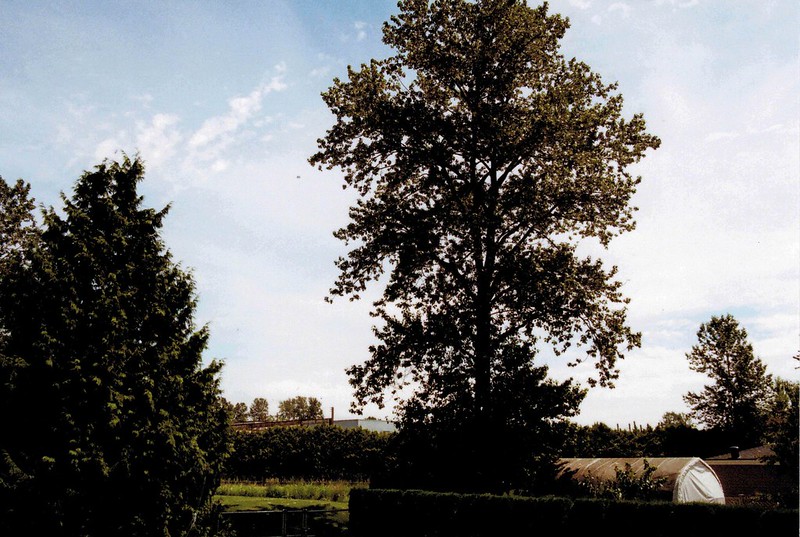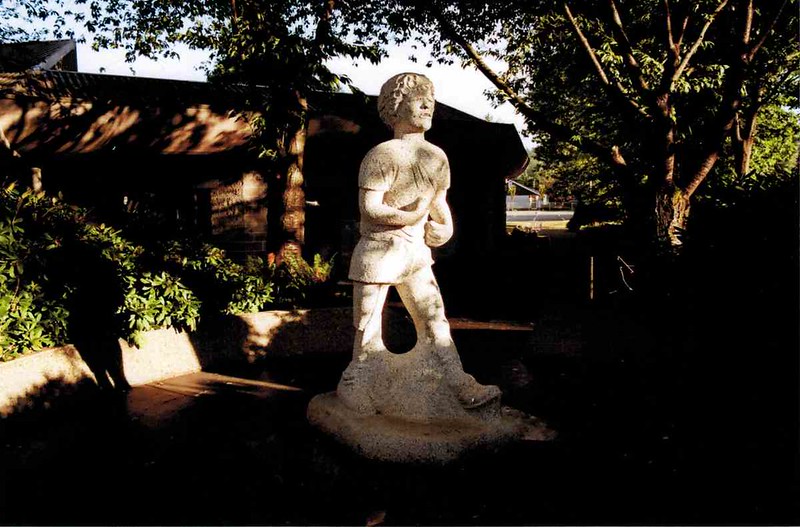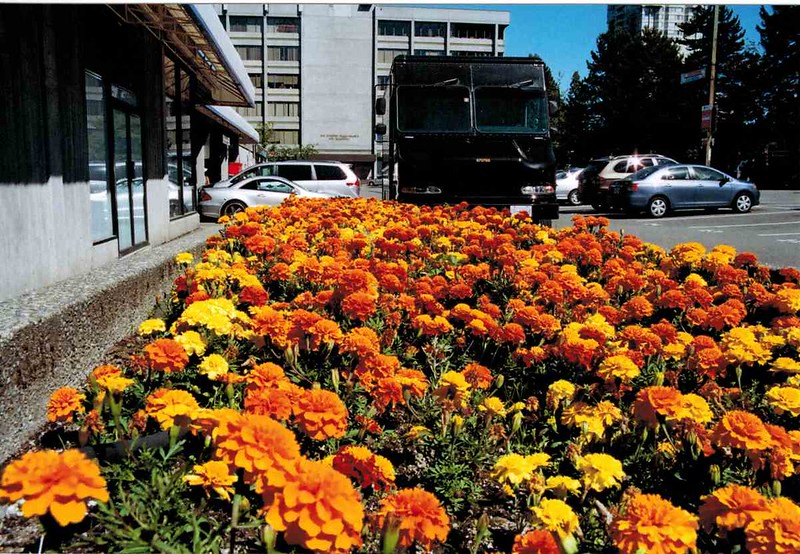A few weeks ago I had the opportunity to acquire a film camera, the Pentax MZ-S, through my local Craigslist listings. The camera was in perfect working order and in overall excellent condition. I only got into photography last October, but I've been shooting exclusively with digital Pentax cameras (a K30 and a Q) and I've always wanted to give film a try. Luckily this opportunity came up, so I decided to make it a project of sorts.
So off I went to London Drugs to get me some film and CR-2 batteries. A quick read of the pdf manual online helped me set the settings I wanted. The name of the game was being simple as possible, so I just kept it in P mode, with center-weighted metering. And from there, the shooting started. My goal was to get through one roll of film, and then decide after that if I wanted to continue shooting more with it.
(note: the pictures here were scanned from the only scanner I have easy access to, which is the crappy scanner at my work. The scanner is not that good to begin with, but as you'll sometimes see there are blobs of whiteout on the pictures thanks to people putting documents with fresh Whiteout on the scanner glass and ruining it forever. I probably would have been better off taking a picture of the developed photos with my K30 and sharing it that way since they actually did turn out quite decent).  This was the second shot I took with the MZ-S (the first is a blurred shot of my stove). It is a massive tree in my neighbor's backyard, a frequent test subject of mine.
This was the second shot I took with the MZ-S (the first is a blurred shot of my stove). It is a massive tree in my neighbor's backyard, a frequent test subject of mine.
Obviously the MZ-S and the photos I was taking with it would have to be treated differently from my K30. I would not be able to just take the MZ-S and go for a stroll to "see what might come up". With only 24 shots total per roll, and with each shot costing me a few bucks, I would have to be more careful. The approach I decided to take was greatly inspired bySteve McCurry's treatment of the last roll of Kodachrome film:
I would have to sort of pre-envision a shot, or at least be going to a place where I was almost sure a shot would present itself (because I had been to the place before), and once I was pretty sure I had something there, only then try and execute the picture.
 There are several families of ducks that live near me. I see them everyday on my way to work. They're an interesting bunch. The number of ducklings fluctuate as some of them die and as new ones are born. I knew I had to get at least one picture of the ducks on film.
There are several families of ducks that live near me. I see them everyday on my way to work. They're an interesting bunch. The number of ducklings fluctuate as some of them die and as new ones are born. I knew I had to get at least one picture of the ducks on film.
The camera came with two lenses. The first lens was the FA 28-200, an old workhorse superzoom. Being the owner of another superzoom (the DA 18-250) I was well aware of the limitations of such a lens. In good light, these lenses are unmatched for their versatility relative to their image quality output. But the second there is any sort of shade or cloud cover or decreased light, the image quality degrades quite precipitously. With that in mind, I made sure to give the lens plenty of help by shooting in good light. However as time wore one I got a little more bold, and decided to see how the lens performed in shaded areas or even at night. The results were surprisingly decent. Perfectly acceptable for casual memory capture, though I'm unsure how much of it was because of the lens, or how much of it was from the MZ-S.
 This statue is of the late great Terry Fox, one of the greatest Canadians ever. It was horribly gimped up by the statue creators though. I was concerned about how the FA 28-200 would deal with the mottled shadows, but I think it's quite decent.
This statue is of the late great Terry Fox, one of the greatest Canadians ever. It was horribly gimped up by the statue creators though. I was concerned about how the FA 28-200 would deal with the mottled shadows, but I think it's quite decent. 
The second lens that came with the MZ-S was the F 17-28 Fisheye. Having acquired another fisheye lens recently (the 03 Prime for my Pentax Q), I had a little bit of fisheye technique under my belt so I was confident that I would be able to produce serviceable shots. The end results were all really good to me, and my respect for the fisheye perspective has essentially been solidified by this experience.


As the project wore on I began to take note of some of the differences between shooting with a film camera as opposed to shooting with a DSLR. The fact I could not just "spray and pray" like I do with my K30 really forced me to slow down and analyze a scene or situation before pulling the trigger. This sometimes meant walking around and around the same scene or doing multiple passes to and from a subject before deciding to pull the trigger. With my K30, I would have just taken a picture from any and all angles that presented a chance of potential, and then analyzed all the pictures at home to decide which one was best.
 For this picture I first took a shot with my K30 to see if the angle was right before taking the shot with the MZ-S.
For this picture I first took a shot with my K30 to see if the angle was right before taking the shot with the MZ-S.
Another curious thing presented itself: anticipation! It showed itself after I took what I thought was a great shot, but knowing that I would have to wait until the roll was done to see if that was the case. Also, since the project rolled on for a few weeks, I actually forgot what some of the earlier pictures actually were, which led me to feel really excited about what was going to come out of the photo lab. This feeling is the sort of thing that is lost in today's era of the instant review.
 I was really curious to see how this shot would turn out because of the sun being directly in the frame. It turned out surprisingly well.
I was really curious to see how this shot would turn out because of the sun being directly in the frame. It turned out surprisingly well.
There are drawbacks to shooting with film though. Buying film and processing it isn't that expensive, but considering that you only get 24 shots from a roll, it is. This leads to less shots, which yes can be a good thing in the sense that it leads one to be more thoughtful about what they're taking a picture of. But how many missed moments does that represent? How many shots have been ruined by something such as an errant blink or a person walking by or a misfocus? National Geographic reporters have reported taking
between 20,000 to 60,000 shots and culling it down to just a dozen per assignment, which to me makes sense: It's all about capturing the moment, not how you capture the moment. The digital realm has removed that concern, and on the whole I think it has made photography better.
 I would have loved to play with the colors on this one in Lightroom and made them super punchy. Maybe a bit of cropping too. And using Lightroom to suck back some of the blacked-out details on the dock and on the bridge.
I would have loved to play with the colors on this one in Lightroom and made them super punchy. Maybe a bit of cropping too. And using Lightroom to suck back some of the blacked-out details on the dock and on the bridge.
Processing film is another thing. A few of the shots I developed I would have liked to give some processing work to in Lightroom, but with film, that's way harder to do. This leads to a reduction in keeper rate, where a shot that might be salvaged through some manner of processing gets ditched because it's not worth the trouble.
Out of the 25 shots taken from the roll of film, 3 turned out to be just blurred blobs, and from the rest, half fall into the keeper category, while the other half count as just casual snaps. I think the keeper count could have been increased if I was able to process some of the pictures in something like Lightroom.
This experience was great for me. It gave me a glimpse of how it was "back in the day". And it doesn't seem that bad. My respect for the photographers of yore has just gone up tremendously, and I'm sure there are many more things I can learn from continuing to shoot film with the MZ-S. But there's even more things in the digital realm for me to learn, things such as new processing techniques, or new ways of shooting. I've been playing around with bracketing and combining shots recently, and I've seen just about enough inspiring time lapse videos (virtually impossible to do with film) that I feel like I should give that a go too.
 There was one more shot left on the roll when I brought it up to the photo lab counter for development. I asked the lab tech to take a picture of me. To my horror, he just raised the camera an inch off the counter and snapped a pic. I tried to duck down so at least my face was level with the lens, but it turned out all blurry. Luckily, the film gods allowed the roll to exceed the 24 shot limit that was labelled on box. With one more shot left, the lab tech actually raised the camera up to his chest before pressing the shutter button. I wasn't sure how it would look since he didn't try and focus the lens, but it turned out quite all right.
There was one more shot left on the roll when I brought it up to the photo lab counter for development. I asked the lab tech to take a picture of me. To my horror, he just raised the camera an inch off the counter and snapped a pic. I tried to duck down so at least my face was level with the lens, but it turned out all blurry. Luckily, the film gods allowed the roll to exceed the 24 shot limit that was labelled on box. With one more shot left, the lab tech actually raised the camera up to his chest before pressing the shutter button. I wasn't sure how it would look since he didn't try and focus the lens, but it turned out quite all right.
So the MZ-S is now sitting on my shelf, ready and waiting to be passed on to another fellow photographer. Right now, it's not for me, since there is still so much out there to try out in the digital realm. But since this project was a great experience, I would definitely give film another go in the future (I just don't need a Rolls Royce film camera like the MZ-S to do it). I know an old film pro can really make this camera sing and make magic with it, but I secretly hope that another person who was like me, someone who knows nothing of film but wants to try it out, picks up this film camera and gives it a go.
A few more pictures that were taken with the MZ-S. 




Last edited by EarlVonTapia; 07-28-2013 at 03:13 PM.


 Similar Threads
Similar Threads 




























 Post #1 by EarlVonTapia
Post #1 by EarlVonTapia








